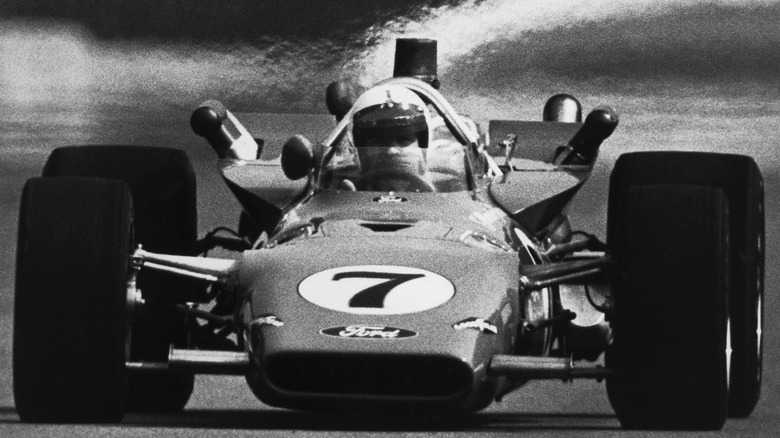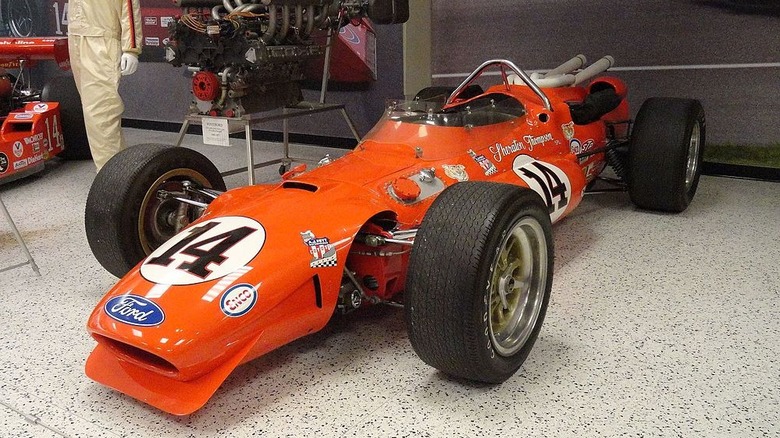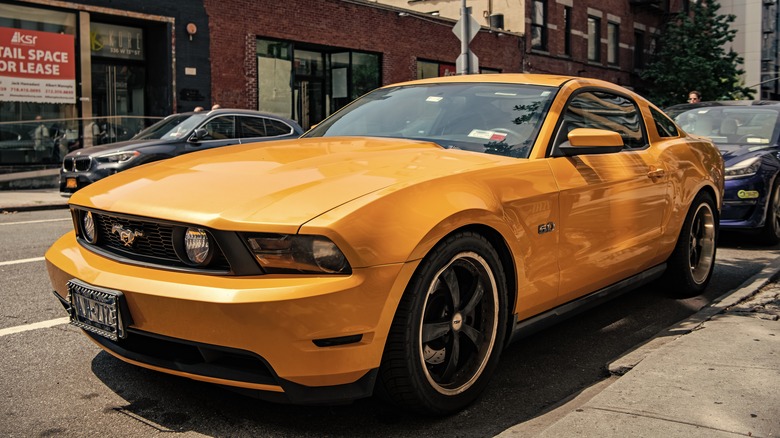The Legendary IndyCar That Gave Ford's Coyote Engine Its Name
When Ford launched its new GT Mustang model in 2011, it also unveiled the sleek, cutting-edge V8 engine that would propel the car. "The Coyote" — one of the most powerful Mustang engines ever – was a revolutionary 5-liter piece of masterclass engineering that would elevate motor standards with its impressive durability and stats, including a max of 500 horsepower at 418 pound-feet of torque.
Ford was betting a lot on this motor, which had to work within the preconfigured compartment space of the Mustang while also competing at a level rivaling contenders like the Dodge Camaro and Chevrolet Challenger. Fortunately this modernized Coyote engine rose to the occasion and is widely considered one of the best V8 engines ever made because of its well-balanced fuel efficiency and performance. For more than a decade now, this engine has not only been considered the go-to engine for each new Mustang model, but has also become an engine owners love to swap into older Mustangs.
But where did Ford come up with the name "Coyote," and why is it such an apt moniker for this engine? For that answer, we take a dive into the history of the legendary racing champion and Ford driver A.J. Foyt.
The Coyote was the nickname of A.J. Foyt's V8 race car
A.J. Foyt cemented his legacy in American racing when he shattered records on May 29, 1977 as the first professional driver to win four Indianapolis 500s. After emerging victorious in 1961 and 1964, Foyt made the pivotal decision to change vehicles before his third Indy 500 in 1967. Instead of opting for the accustomed front-engine Watson-Offy roadster, the six-time United States Auto Club winner selected a new rear-engine vehicle built on a Coyote-brand chassis.
After he won that third Indy 500, the name "Coyote" became synonymous with Foyt's racing career as they seized 25 wins out of a total 141 championships. However, it would be a decade-long odyssey before Foyt and the Coyote would return for his historic fourth triumph at Indianapolis.
During that marathon journey toward the record-breaking Indy 500, Foyt drove four distinctive iterations of the Coyote IV from 1973-1978. Working from his Houston hometown, Foyt designed and built the engine for the Coyote IV, remaining the only driver to date to have done so.
With each iteration, Foyt and his Coyote consistently ranked either second or third throughout the 1970s. It would be the '75 version of the Coyote IV that would eventually lead Foyt to his record-breaking fourth Indy 500 win, with just some slight modifications such as a lowered cockpit and trimmed-down body to reduce wind resistance.
[Featured image by NaBUru38 via Wikimedia Commons | Cropped and scaled | CC BY-SA 4.0]
A legendary name Ford's engine can measure up to
A.J. Foyt has long since hung up his racing uniform, but he still maintains a prominent leadership role in the Foyt/Coyote racing team. With such an esteemed racing career as the one garnered by the name "Coyote," any product sharing that moniker has quite the legacy to maintain.
But since its explosive entrance into the market in 2011, Ford's high-caliber Coyote engine has continued to far surpass expectations, evolving beyond the Mustang model to also powering utility vehicles and trucks. A blend of exceptional materials topped off with the magic ingredient of twin independent variable camshaft timing is what makes these motors so reliable, maximizing torque while simultaneously enhancing emissions.
Given the rave reviews and successful track record of the 2024 version, it's little wonder that Ford has already confirmed the Coyote engine will continue to power the Mustang for the foreseeable future.


